Types of Businesses and Their Classification
VerifiedAdded on 2022/12/26
|14
|2243
|39
AI Summary
This document provides an overview of different types of businesses and their classification. It discusses the working of different companies, types of ownership in a business, and external factors affecting business processes. The document also includes a case study on the PESTEL analysis of Coca Cola Company.
Contribute Materials
Your contribution can guide someone’s learning journey. Share your
documents today.
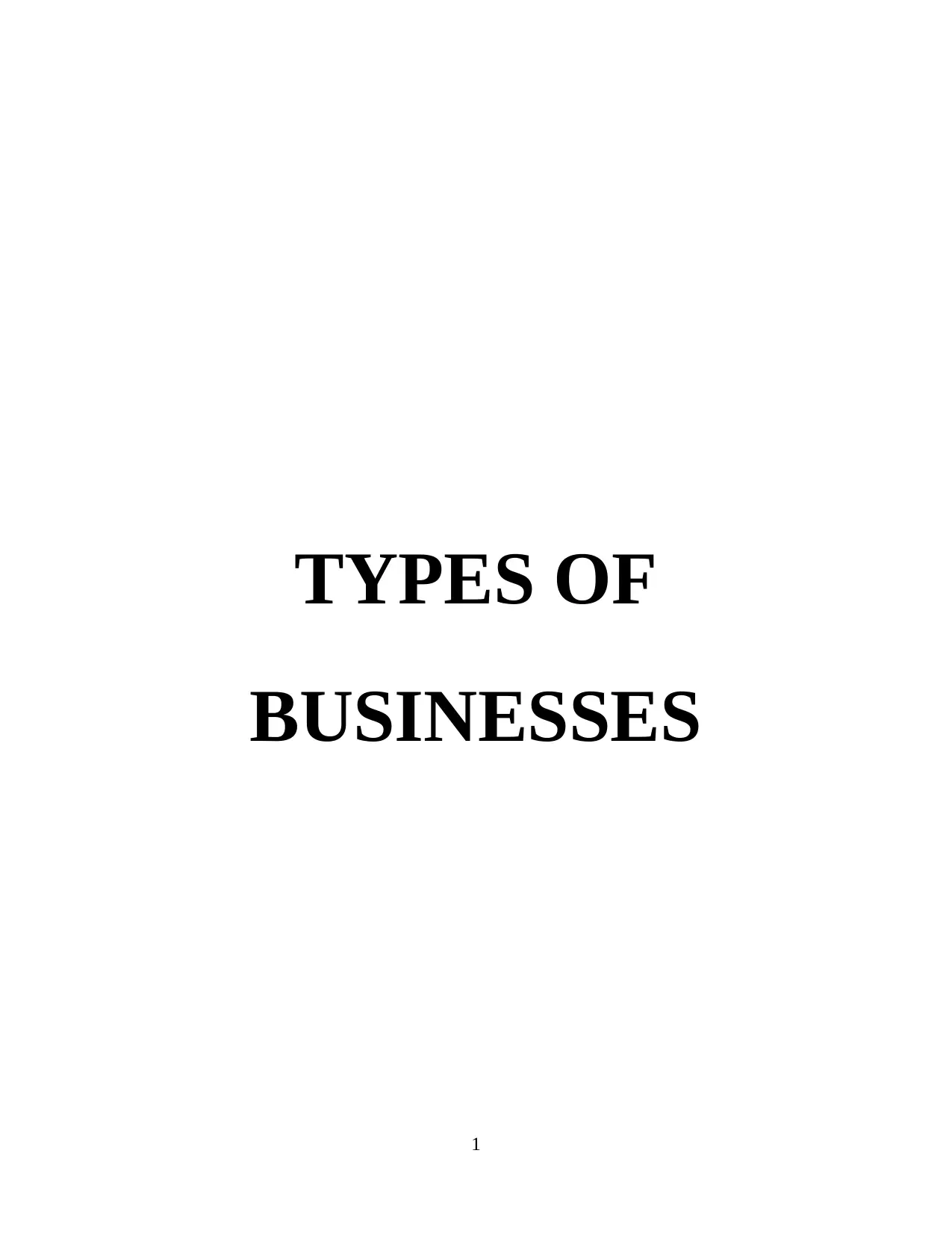
TYPES OF
BUSINESSES
1
BUSINESSES
1
Secure Best Marks with AI Grader
Need help grading? Try our AI Grader for instant feedback on your assignments.

2
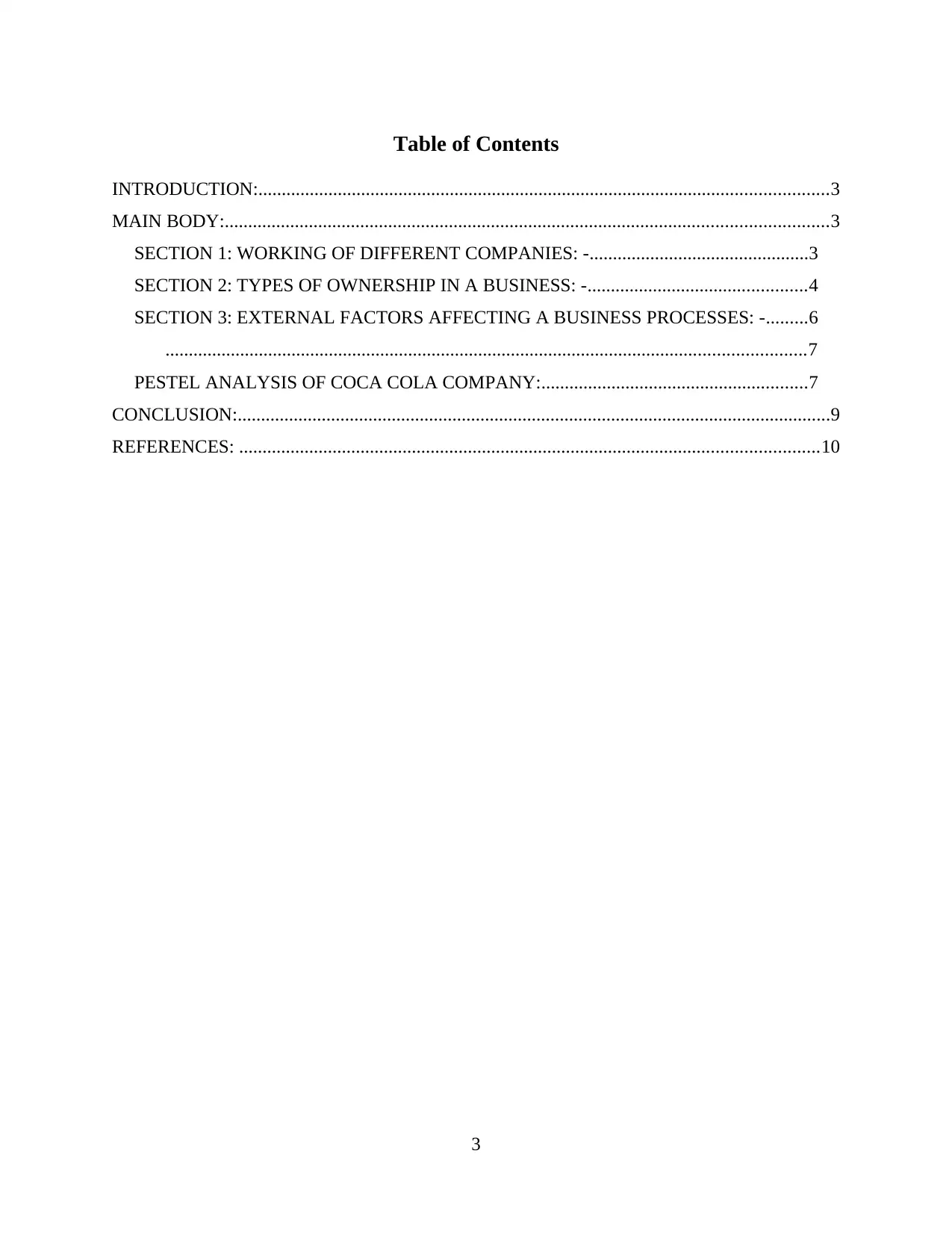
Table of Contents
INTRODUCTION:..........................................................................................................................3
MAIN BODY:.................................................................................................................................3
SECTION 1: WORKING OF DIFFERENT COMPANIES: -...............................................3
SECTION 2: TYPES OF OWNERSHIP IN A BUSINESS: -...............................................4
SECTION 3: EXTERNAL FACTORS AFFECTING A BUSINESS PROCESSES: -.........6
.........................................................................................................................................7
PESTEL ANALYSIS OF COCA COLA COMPANY:.........................................................7
CONCLUSION:...............................................................................................................................9
REFERENCES: ............................................................................................................................10
3
INTRODUCTION:..........................................................................................................................3
MAIN BODY:.................................................................................................................................3
SECTION 1: WORKING OF DIFFERENT COMPANIES: -...............................................3
SECTION 2: TYPES OF OWNERSHIP IN A BUSINESS: -...............................................4
SECTION 3: EXTERNAL FACTORS AFFECTING A BUSINESS PROCESSES: -.........6
.........................................................................................................................................7
PESTEL ANALYSIS OF COCA COLA COMPANY:.........................................................7
CONCLUSION:...............................................................................................................................9
REFERENCES: ............................................................................................................................10
3
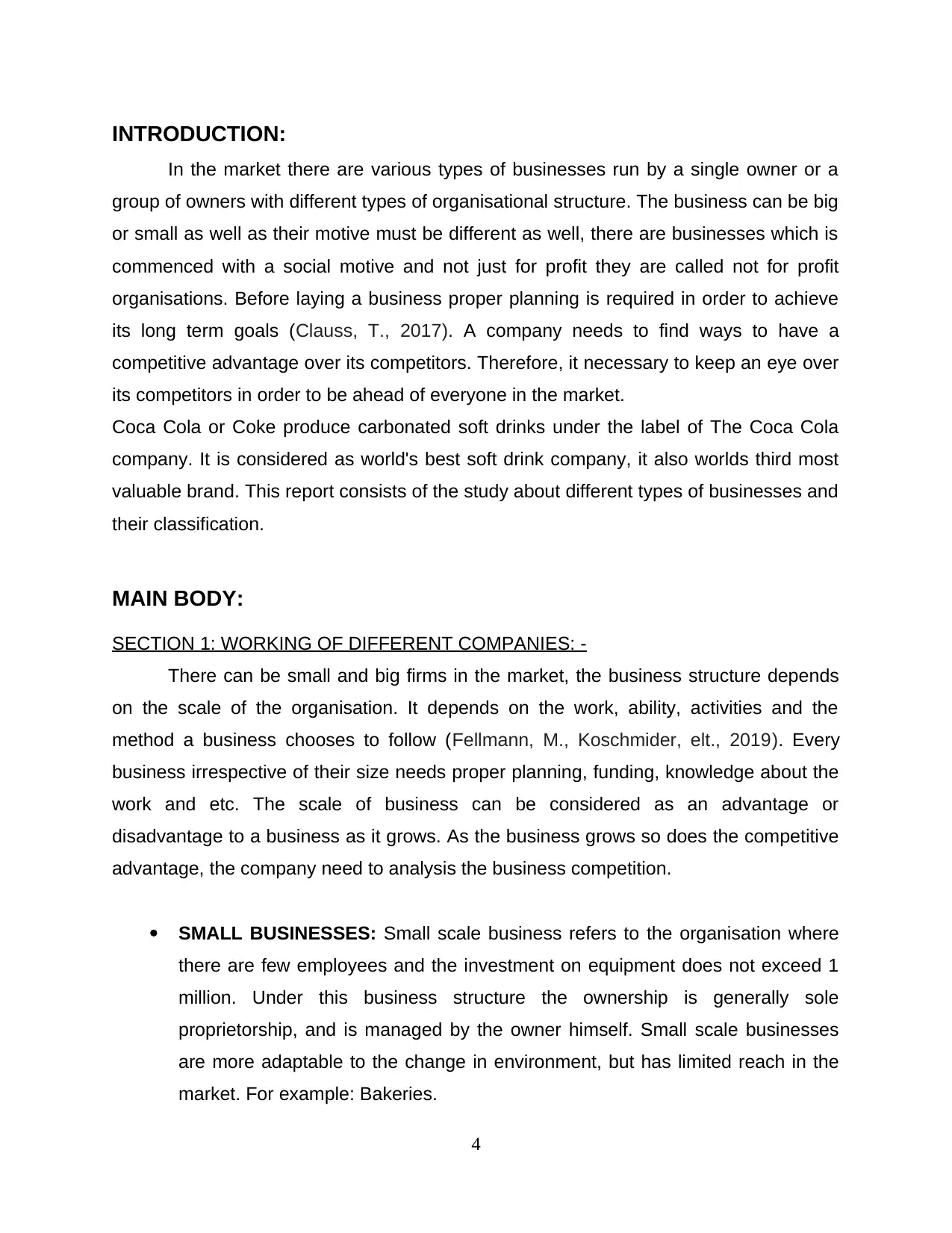
INTRODUCTION:
In the market there are various types of businesses run by a single owner or a
group of owners with different types of organisational structure. The business can be big
or small as well as their motive must be different as well, there are businesses which is
commenced with a social motive and not just for profit they are called not for profit
organisations. Before laying a business proper planning is required in order to achieve
its long term goals (Clauss, T., 2017). A company needs to find ways to have a
competitive advantage over its competitors. Therefore, it necessary to keep an eye over
its competitors in order to be ahead of everyone in the market.
Coca Cola or Coke produce carbonated soft drinks under the label of The Coca Cola
company. It is considered as world's best soft drink company, it also worlds third most
valuable brand. This report consists of the study about different types of businesses and
their classification.
MAIN BODY:
SECTION 1: WORKING OF DIFFERENT COMPANIES: -
There can be small and big firms in the market, the business structure depends
on the scale of the organisation. It depends on the work, ability, activities and the
method a business chooses to follow (Fellmann, M., Koschmider, elt., 2019). Every
business irrespective of their size needs proper planning, funding, knowledge about the
work and etc. The scale of business can be considered as an advantage or
disadvantage to a business as it grows. As the business grows so does the competitive
advantage, the company need to analysis the business competition.
SMALL BUSINESSES: Small scale business refers to the organisation where
there are few employees and the investment on equipment does not exceed 1
million. Under this business structure the ownership is generally sole
proprietorship, and is managed by the owner himself. Small scale businesses
are more adaptable to the change in environment, but has limited reach in the
market. For example: Bakeries.
4
In the market there are various types of businesses run by a single owner or a
group of owners with different types of organisational structure. The business can be big
or small as well as their motive must be different as well, there are businesses which is
commenced with a social motive and not just for profit they are called not for profit
organisations. Before laying a business proper planning is required in order to achieve
its long term goals (Clauss, T., 2017). A company needs to find ways to have a
competitive advantage over its competitors. Therefore, it necessary to keep an eye over
its competitors in order to be ahead of everyone in the market.
Coca Cola or Coke produce carbonated soft drinks under the label of The Coca Cola
company. It is considered as world's best soft drink company, it also worlds third most
valuable brand. This report consists of the study about different types of businesses and
their classification.
MAIN BODY:
SECTION 1: WORKING OF DIFFERENT COMPANIES: -
There can be small and big firms in the market, the business structure depends
on the scale of the organisation. It depends on the work, ability, activities and the
method a business chooses to follow (Fellmann, M., Koschmider, elt., 2019). Every
business irrespective of their size needs proper planning, funding, knowledge about the
work and etc. The scale of business can be considered as an advantage or
disadvantage to a business as it grows. As the business grows so does the competitive
advantage, the company need to analysis the business competition.
SMALL BUSINESSES: Small scale business refers to the organisation where
there are few employees and the investment on equipment does not exceed 1
million. Under this business structure the ownership is generally sole
proprietorship, and is managed by the owner himself. Small scale businesses
are more adaptable to the change in environment, but has limited reach in the
market. For example: Bakeries.
4
Secure Best Marks with AI Grader
Need help grading? Try our AI Grader for instant feedback on your assignments.
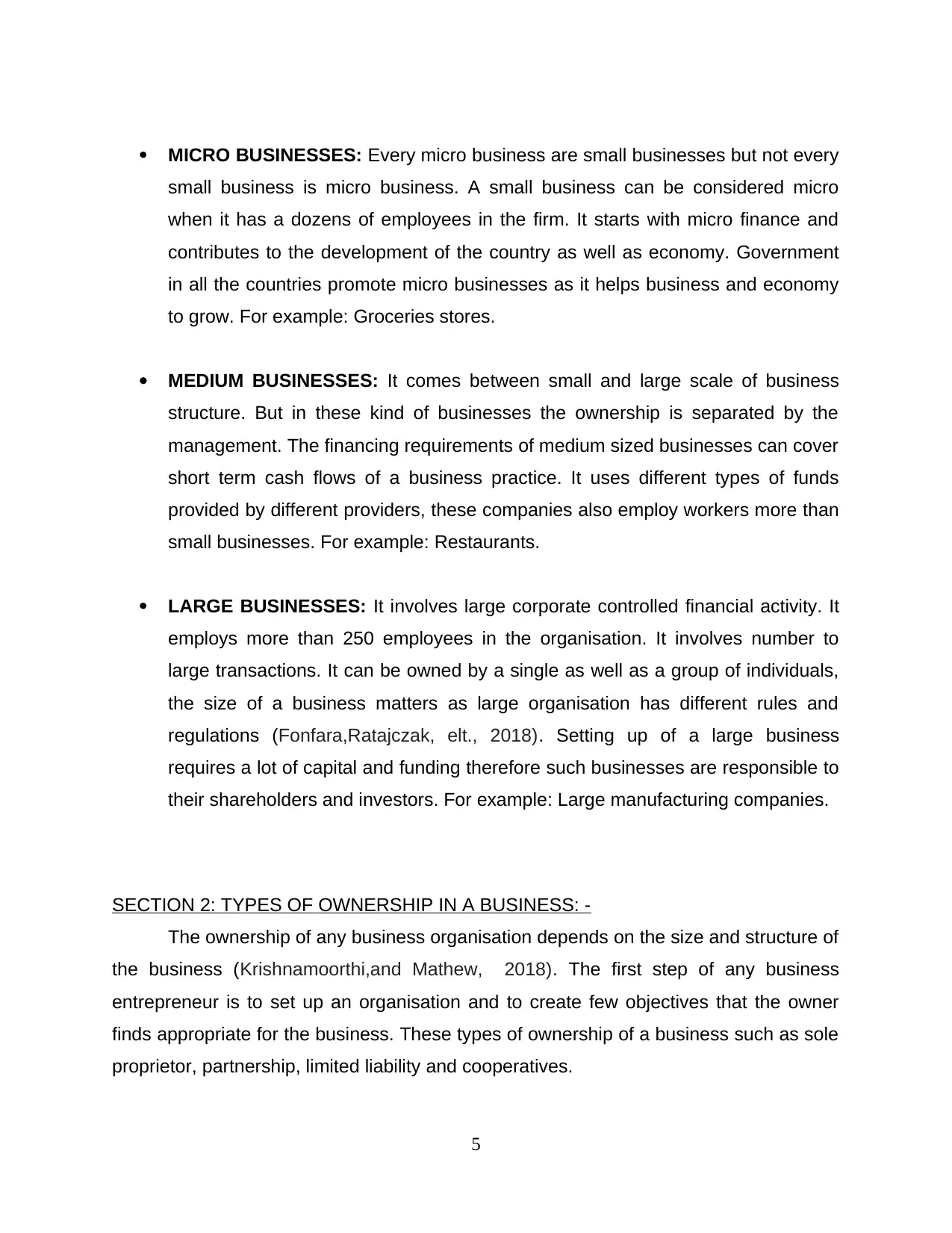
MICRO BUSINESSES: Every micro business are small businesses but not every
small business is micro business. A small business can be considered micro
when it has a dozens of employees in the firm. It starts with micro finance and
contributes to the development of the country as well as economy. Government
in all the countries promote micro businesses as it helps business and economy
to grow. For example: Groceries stores.
MEDIUM BUSINESSES: It comes between small and large scale of business
structure. But in these kind of businesses the ownership is separated by the
management. The financing requirements of medium sized businesses can cover
short term cash flows of a business practice. It uses different types of funds
provided by different providers, these companies also employ workers more than
small businesses. For example: Restaurants.
LARGE BUSINESSES: It involves large corporate controlled financial activity. It
employs more than 250 employees in the organisation. It involves number to
large transactions. It can be owned by a single as well as a group of individuals,
the size of a business matters as large organisation has different rules and
regulations (Fonfara,Ratajczak, elt., 2018). Setting up of a large business
requires a lot of capital and funding therefore such businesses are responsible to
their shareholders and investors. For example: Large manufacturing companies.
SECTION 2: TYPES OF OWNERSHIP IN A BUSINESS: -
The ownership of any business organisation depends on the size and structure of
the business (Krishnamoorthi,and Mathew, 2018). The first step of any business
entrepreneur is to set up an organisation and to create few objectives that the owner
finds appropriate for the business. These types of ownership of a business such as sole
proprietor, partnership, limited liability and cooperatives.
5
small business is micro business. A small business can be considered micro
when it has a dozens of employees in the firm. It starts with micro finance and
contributes to the development of the country as well as economy. Government
in all the countries promote micro businesses as it helps business and economy
to grow. For example: Groceries stores.
MEDIUM BUSINESSES: It comes between small and large scale of business
structure. But in these kind of businesses the ownership is separated by the
management. The financing requirements of medium sized businesses can cover
short term cash flows of a business practice. It uses different types of funds
provided by different providers, these companies also employ workers more than
small businesses. For example: Restaurants.
LARGE BUSINESSES: It involves large corporate controlled financial activity. It
employs more than 250 employees in the organisation. It involves number to
large transactions. It can be owned by a single as well as a group of individuals,
the size of a business matters as large organisation has different rules and
regulations (Fonfara,Ratajczak, elt., 2018). Setting up of a large business
requires a lot of capital and funding therefore such businesses are responsible to
their shareholders and investors. For example: Large manufacturing companies.
SECTION 2: TYPES OF OWNERSHIP IN A BUSINESS: -
The ownership of any business organisation depends on the size and structure of
the business (Krishnamoorthi,and Mathew, 2018). The first step of any business
entrepreneur is to set up an organisation and to create few objectives that the owner
finds appropriate for the business. These types of ownership of a business such as sole
proprietor, partnership, limited liability and cooperatives.
5
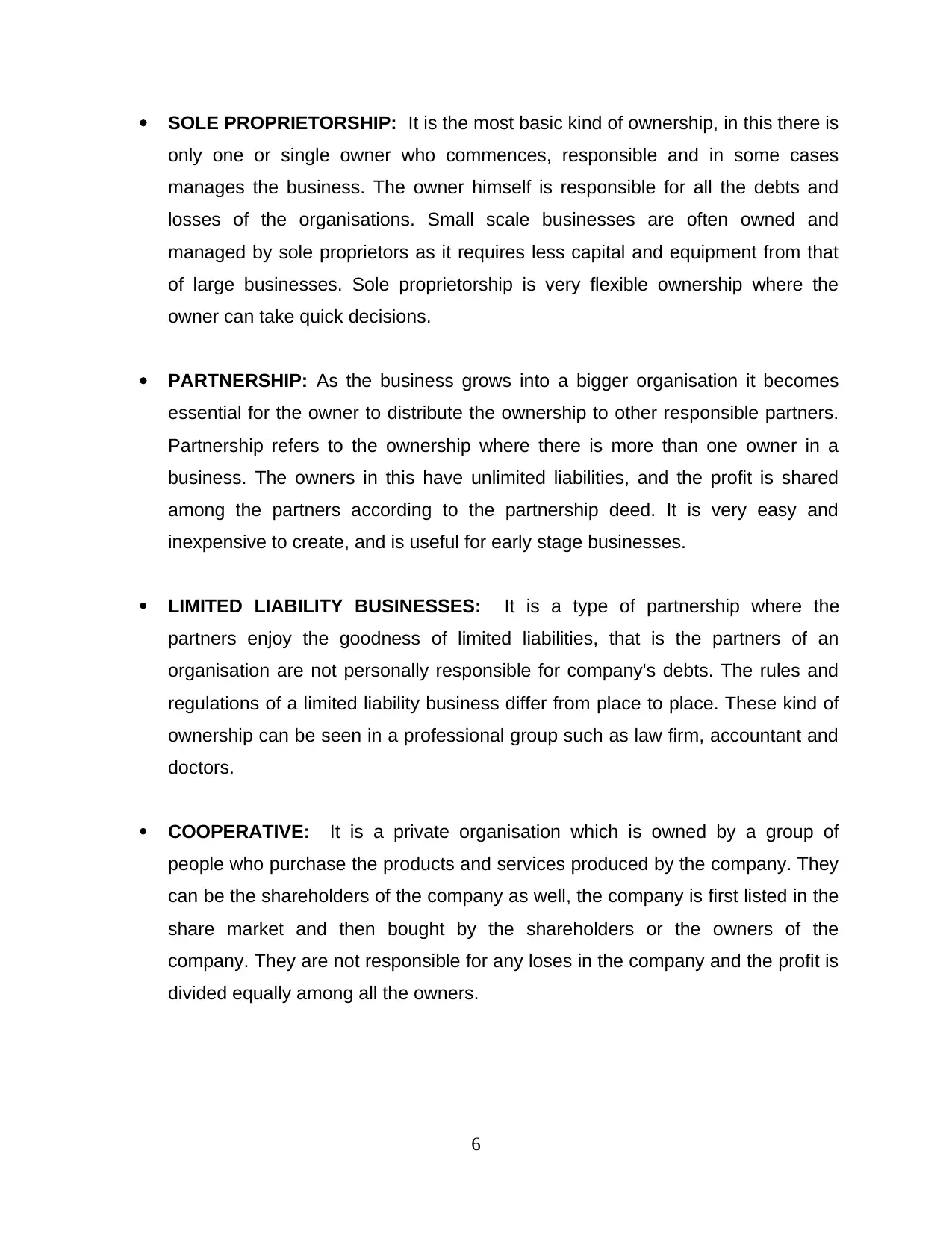
SOLE PROPRIETORSHIP: It is the most basic kind of ownership, in this there is
only one or single owner who commences, responsible and in some cases
manages the business. The owner himself is responsible for all the debts and
losses of the organisations. Small scale businesses are often owned and
managed by sole proprietors as it requires less capital and equipment from that
of large businesses. Sole proprietorship is very flexible ownership where the
owner can take quick decisions.
PARTNERSHIP: As the business grows into a bigger organisation it becomes
essential for the owner to distribute the ownership to other responsible partners.
Partnership refers to the ownership where there is more than one owner in a
business. The owners in this have unlimited liabilities, and the profit is shared
among the partners according to the partnership deed. It is very easy and
inexpensive to create, and is useful for early stage businesses.
LIMITED LIABILITY BUSINESSES: It is a type of partnership where the
partners enjoy the goodness of limited liabilities, that is the partners of an
organisation are not personally responsible for company's debts. The rules and
regulations of a limited liability business differ from place to place. These kind of
ownership can be seen in a professional group such as law firm, accountant and
doctors.
COOPERATIVE: It is a private organisation which is owned by a group of
people who purchase the products and services produced by the company. They
can be the shareholders of the company as well, the company is first listed in the
share market and then bought by the shareholders or the owners of the
company. They are not responsible for any loses in the company and the profit is
divided equally among all the owners.
6
only one or single owner who commences, responsible and in some cases
manages the business. The owner himself is responsible for all the debts and
losses of the organisations. Small scale businesses are often owned and
managed by sole proprietors as it requires less capital and equipment from that
of large businesses. Sole proprietorship is very flexible ownership where the
owner can take quick decisions.
PARTNERSHIP: As the business grows into a bigger organisation it becomes
essential for the owner to distribute the ownership to other responsible partners.
Partnership refers to the ownership where there is more than one owner in a
business. The owners in this have unlimited liabilities, and the profit is shared
among the partners according to the partnership deed. It is very easy and
inexpensive to create, and is useful for early stage businesses.
LIMITED LIABILITY BUSINESSES: It is a type of partnership where the
partners enjoy the goodness of limited liabilities, that is the partners of an
organisation are not personally responsible for company's debts. The rules and
regulations of a limited liability business differ from place to place. These kind of
ownership can be seen in a professional group such as law firm, accountant and
doctors.
COOPERATIVE: It is a private organisation which is owned by a group of
people who purchase the products and services produced by the company. They
can be the shareholders of the company as well, the company is first listed in the
share market and then bought by the shareholders or the owners of the
company. They are not responsible for any loses in the company and the profit is
divided equally among all the owners.
6
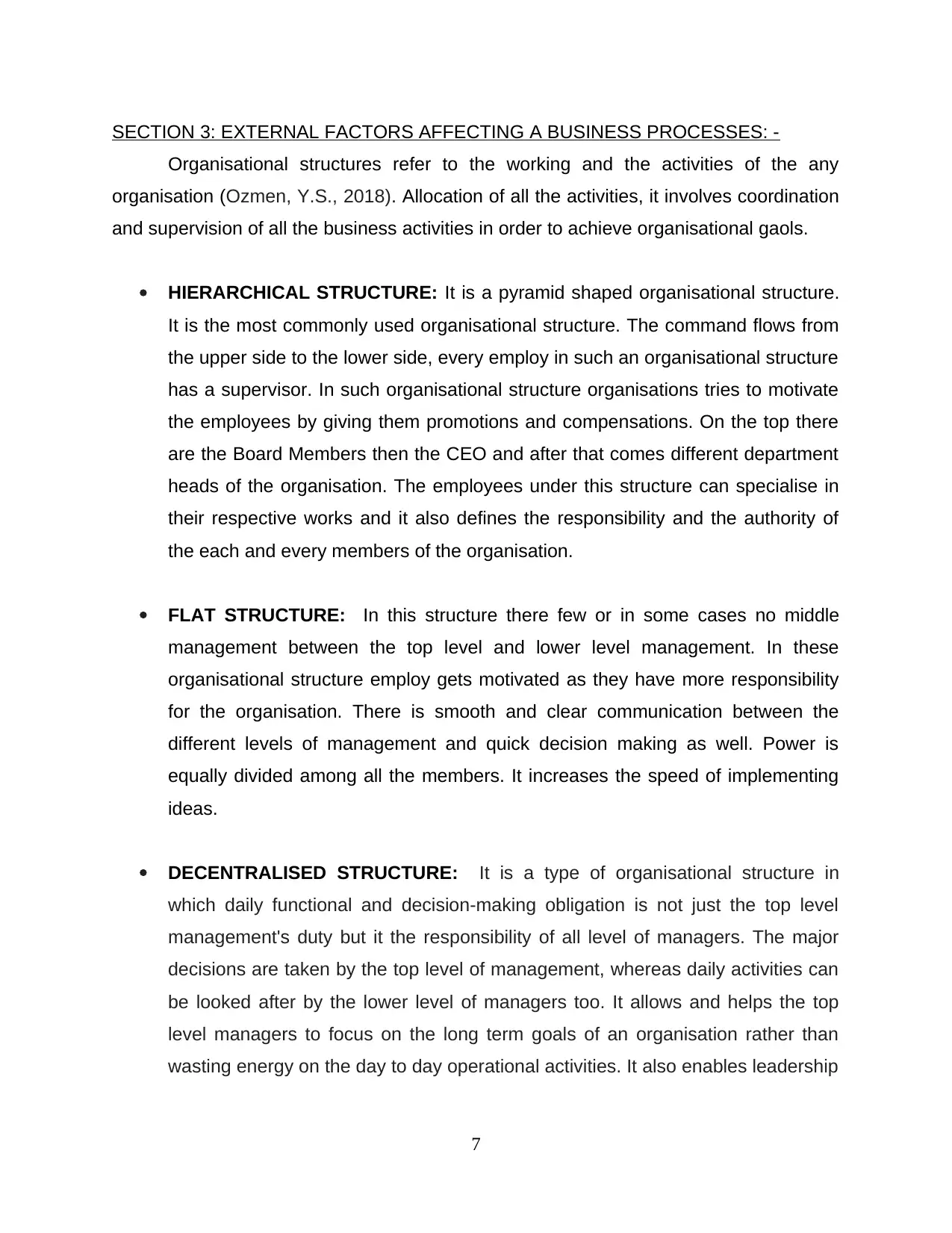
SECTION 3: EXTERNAL FACTORS AFFECTING A BUSINESS PROCESSES: -
Organisational structures refer to the working and the activities of the any
organisation (Ozmen, Y.S., 2018). Allocation of all the activities, it involves coordination
and supervision of all the business activities in order to achieve organisational gaols.
HIERARCHICAL STRUCTURE: It is a pyramid shaped organisational structure.
It is the most commonly used organisational structure. The command flows from
the upper side to the lower side, every employ in such an organisational structure
has a supervisor. In such organisational structure organisations tries to motivate
the employees by giving them promotions and compensations. On the top there
are the Board Members then the CEO and after that comes different department
heads of the organisation. The employees under this structure can specialise in
their respective works and it also defines the responsibility and the authority of
the each and every members of the organisation.
FLAT STRUCTURE: In this structure there few or in some cases no middle
management between the top level and lower level management. In these
organisational structure employ gets motivated as they have more responsibility
for the organisation. There is smooth and clear communication between the
different levels of management and quick decision making as well. Power is
equally divided among all the members. It increases the speed of implementing
ideas.
DECENTRALISED STRUCTURE: It is a type of organisational structure in
which daily functional and decision-making obligation is not just the top level
management's duty but it the responsibility of all level of managers. The major
decisions are taken by the top level of management, whereas daily activities can
be looked after by the lower level of managers too. It allows and helps the top
level managers to focus on the long term goals of an organisation rather than
wasting energy on the day to day operational activities. It also enables leadership
7
Organisational structures refer to the working and the activities of the any
organisation (Ozmen, Y.S., 2018). Allocation of all the activities, it involves coordination
and supervision of all the business activities in order to achieve organisational gaols.
HIERARCHICAL STRUCTURE: It is a pyramid shaped organisational structure.
It is the most commonly used organisational structure. The command flows from
the upper side to the lower side, every employ in such an organisational structure
has a supervisor. In such organisational structure organisations tries to motivate
the employees by giving them promotions and compensations. On the top there
are the Board Members then the CEO and after that comes different department
heads of the organisation. The employees under this structure can specialise in
their respective works and it also defines the responsibility and the authority of
the each and every members of the organisation.
FLAT STRUCTURE: In this structure there few or in some cases no middle
management between the top level and lower level management. In these
organisational structure employ gets motivated as they have more responsibility
for the organisation. There is smooth and clear communication between the
different levels of management and quick decision making as well. Power is
equally divided among all the members. It increases the speed of implementing
ideas.
DECENTRALISED STRUCTURE: It is a type of organisational structure in
which daily functional and decision-making obligation is not just the top level
management's duty but it the responsibility of all level of managers. The major
decisions are taken by the top level of management, whereas daily activities can
be looked after by the lower level of managers too. It allows and helps the top
level managers to focus on the long term goals of an organisation rather than
wasting energy on the day to day operational activities. It also enables leadership
7
Paraphrase This Document
Need a fresh take? Get an instant paraphrase of this document with our AI Paraphraser
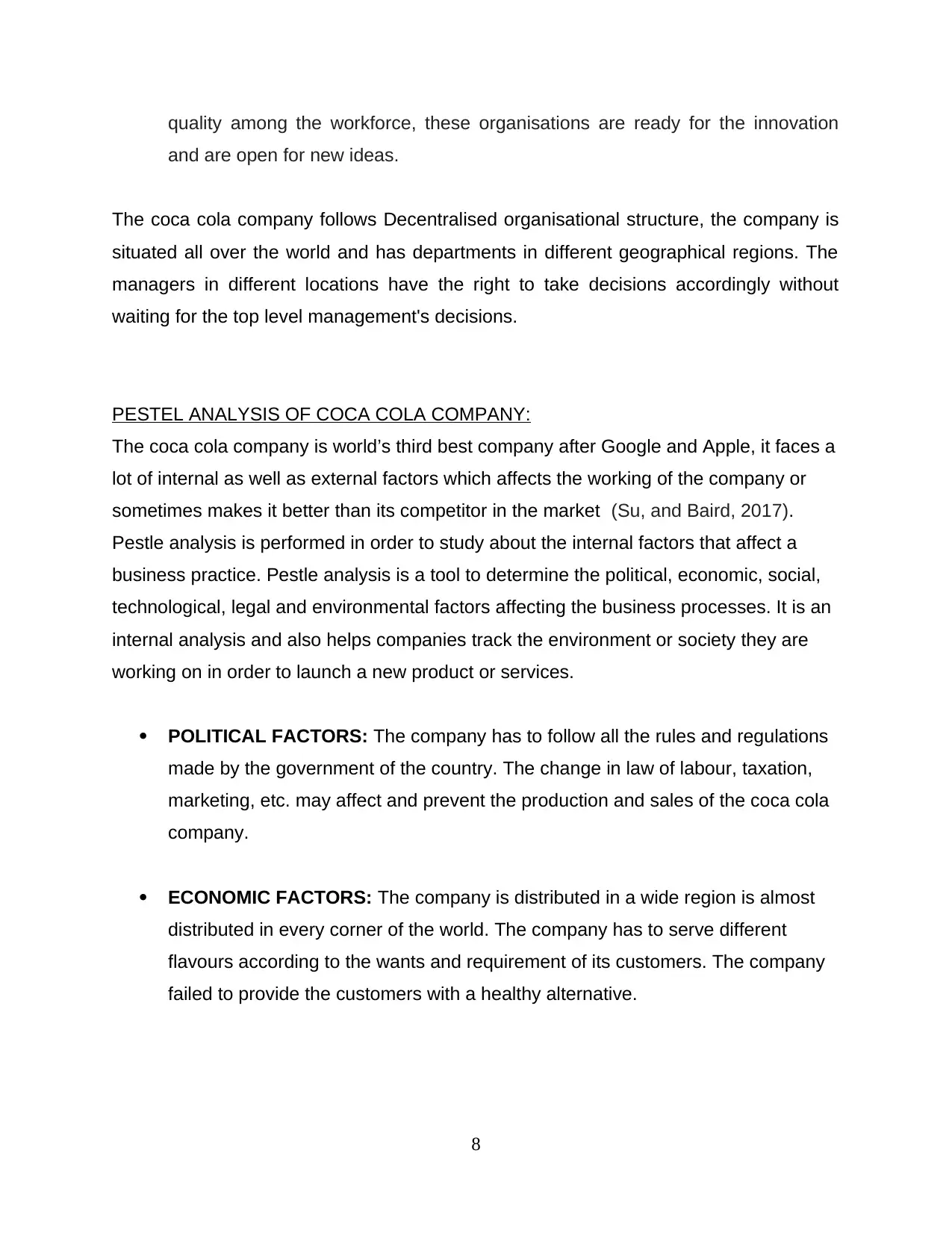
quality among the workforce, these organisations are ready for the innovation
and are open for new ideas.
The coca cola company follows Decentralised organisational structure, the company is
situated all over the world and has departments in different geographical regions. The
managers in different locations have the right to take decisions accordingly without
waiting for the top level management's decisions.
PESTEL ANALYSIS OF COCA COLA COMPANY:
The coca cola company is world’s third best company after Google and Apple, it faces a
lot of internal as well as external factors which affects the working of the company or
sometimes makes it better than its competitor in the market (Su, and Baird, 2017).
Pestle analysis is performed in order to study about the internal factors that affect a
business practice. Pestle analysis is a tool to determine the political, economic, social,
technological, legal and environmental factors affecting the business processes. It is an
internal analysis and also helps companies track the environment or society they are
working on in order to launch a new product or services.
POLITICAL FACTORS: The company has to follow all the rules and regulations
made by the government of the country. The change in law of labour, taxation,
marketing, etc. may affect and prevent the production and sales of the coca cola
company.
ECONOMIC FACTORS: The company is distributed in a wide region is almost
distributed in every corner of the world. The company has to serve different
flavours according to the wants and requirement of its customers. The company
failed to provide the customers with a healthy alternative.
8
and are open for new ideas.
The coca cola company follows Decentralised organisational structure, the company is
situated all over the world and has departments in different geographical regions. The
managers in different locations have the right to take decisions accordingly without
waiting for the top level management's decisions.
PESTEL ANALYSIS OF COCA COLA COMPANY:
The coca cola company is world’s third best company after Google and Apple, it faces a
lot of internal as well as external factors which affects the working of the company or
sometimes makes it better than its competitor in the market (Su, and Baird, 2017).
Pestle analysis is performed in order to study about the internal factors that affect a
business practice. Pestle analysis is a tool to determine the political, economic, social,
technological, legal and environmental factors affecting the business processes. It is an
internal analysis and also helps companies track the environment or society they are
working on in order to launch a new product or services.
POLITICAL FACTORS: The company has to follow all the rules and regulations
made by the government of the country. The change in law of labour, taxation,
marketing, etc. may affect and prevent the production and sales of the coca cola
company.
ECONOMIC FACTORS: The company is distributed in a wide region is almost
distributed in every corner of the world. The company has to serve different
flavours according to the wants and requirement of its customers. The company
failed to provide the customers with a healthy alternative.
8
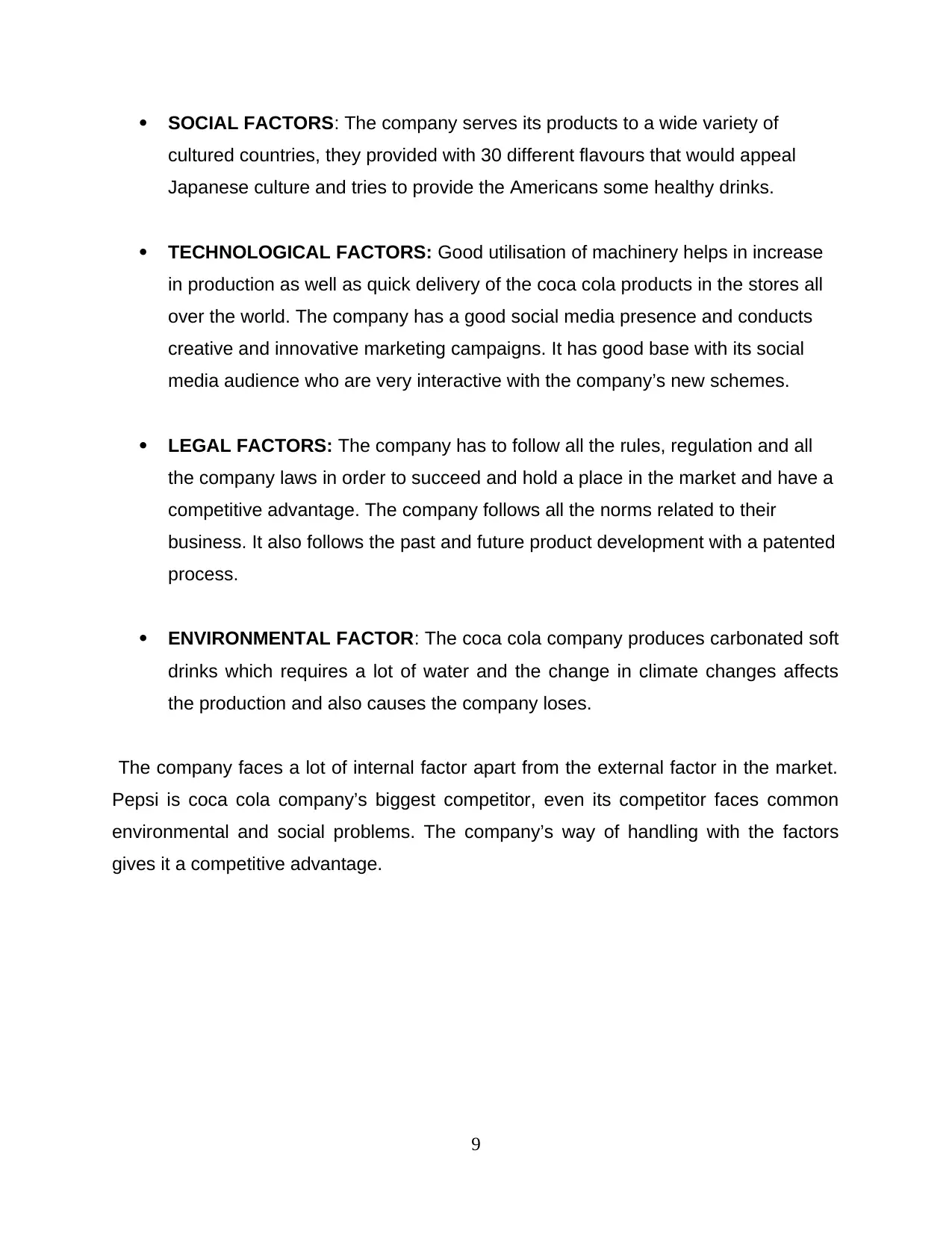
SOCIAL FACTORS: The company serves its products to a wide variety of
cultured countries, they provided with 30 different flavours that would appeal
Japanese culture and tries to provide the Americans some healthy drinks.
TECHNOLOGICAL FACTORS: Good utilisation of machinery helps in increase
in production as well as quick delivery of the coca cola products in the stores all
over the world. The company has a good social media presence and conducts
creative and innovative marketing campaigns. It has good base with its social
media audience who are very interactive with the company’s new schemes.
LEGAL FACTORS: The company has to follow all the rules, regulation and all
the company laws in order to succeed and hold a place in the market and have a
competitive advantage. The company follows all the norms related to their
business. It also follows the past and future product development with a patented
process.
ENVIRONMENTAL FACTOR: The coca cola company produces carbonated soft
drinks which requires a lot of water and the change in climate changes affects
the production and also causes the company loses.
The company faces a lot of internal factor apart from the external factor in the market.
Pepsi is coca cola company’s biggest competitor, even its competitor faces common
environmental and social problems. The company’s way of handling with the factors
gives it a competitive advantage.
9
cultured countries, they provided with 30 different flavours that would appeal
Japanese culture and tries to provide the Americans some healthy drinks.
TECHNOLOGICAL FACTORS: Good utilisation of machinery helps in increase
in production as well as quick delivery of the coca cola products in the stores all
over the world. The company has a good social media presence and conducts
creative and innovative marketing campaigns. It has good base with its social
media audience who are very interactive with the company’s new schemes.
LEGAL FACTORS: The company has to follow all the rules, regulation and all
the company laws in order to succeed and hold a place in the market and have a
competitive advantage. The company follows all the norms related to their
business. It also follows the past and future product development with a patented
process.
ENVIRONMENTAL FACTOR: The coca cola company produces carbonated soft
drinks which requires a lot of water and the change in climate changes affects
the production and also causes the company loses.
The company faces a lot of internal factor apart from the external factor in the market.
Pepsi is coca cola company’s biggest competitor, even its competitor faces common
environmental and social problems. The company’s way of handling with the factors
gives it a competitive advantage.
9
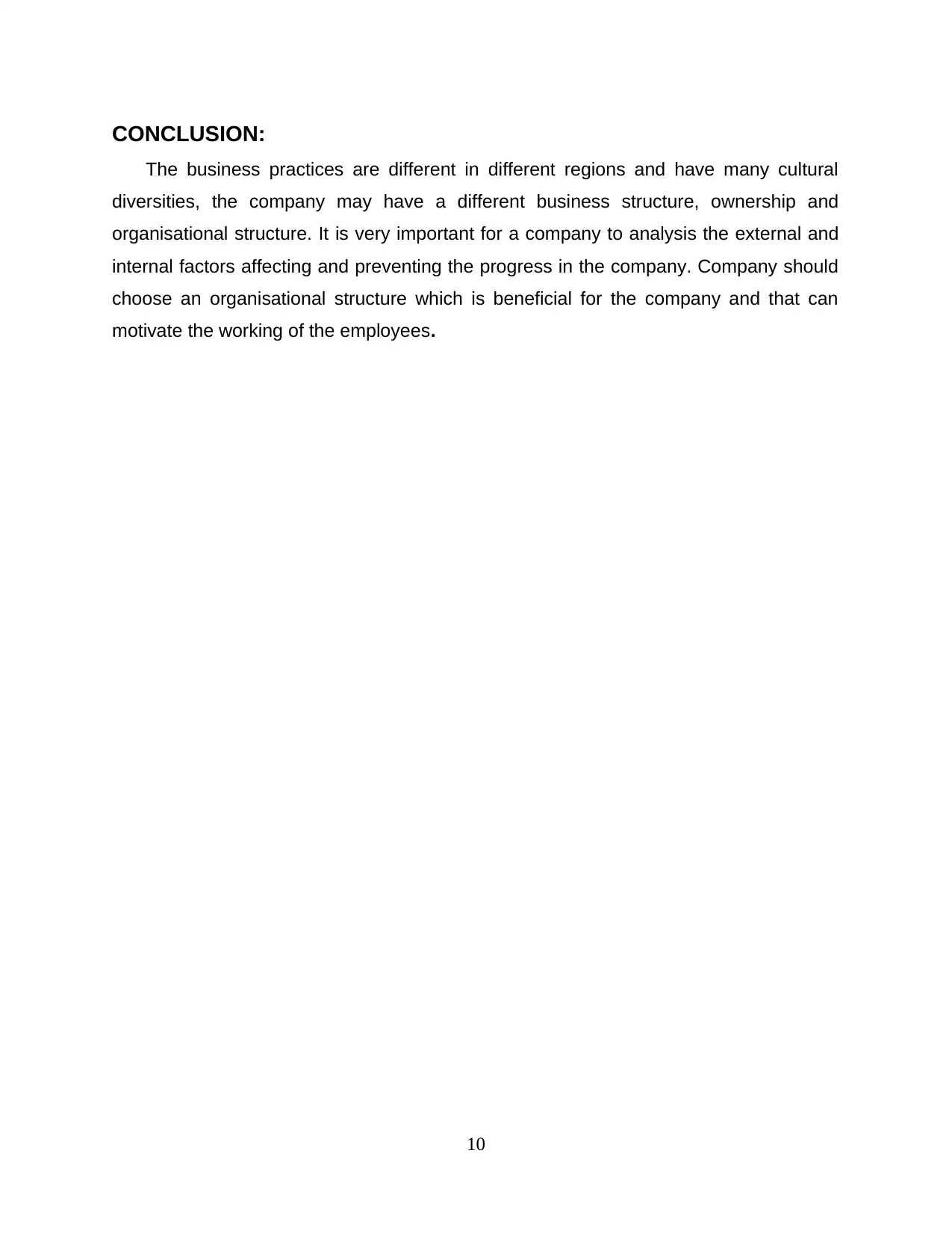
CONCLUSION:
The business practices are different in different regions and have many cultural
diversities, the company may have a different business structure, ownership and
organisational structure. It is very important for a company to analysis the external and
internal factors affecting and preventing the progress in the company. Company should
choose an organisational structure which is beneficial for the company and that can
motivate the working of the employees.
10
The business practices are different in different regions and have many cultural
diversities, the company may have a different business structure, ownership and
organisational structure. It is very important for a company to analysis the external and
internal factors affecting and preventing the progress in the company. Company should
choose an organisational structure which is beneficial for the company and that can
motivate the working of the employees.
10
Secure Best Marks with AI Grader
Need help grading? Try our AI Grader for instant feedback on your assignments.
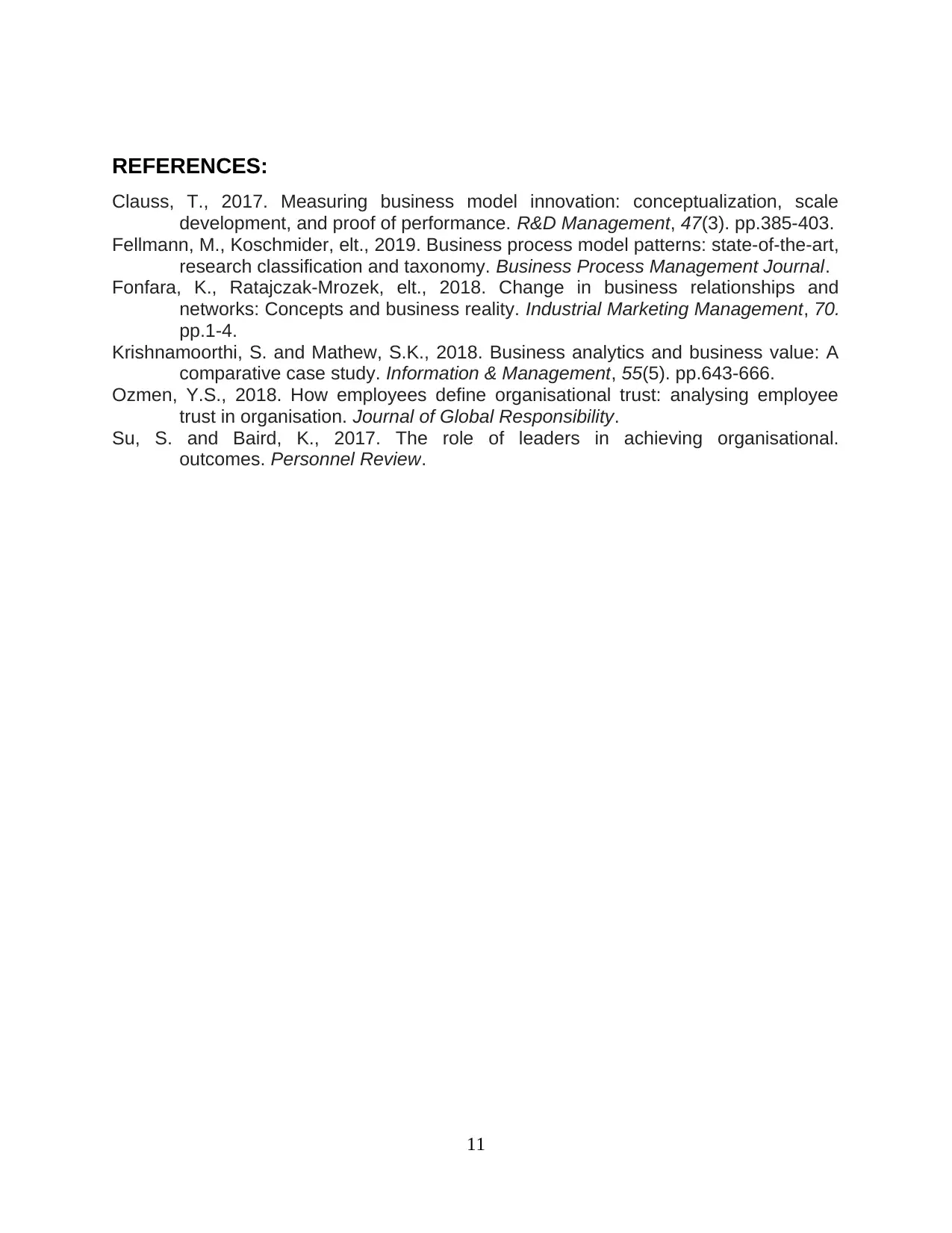
REFERENCES:
Clauss, T., 2017. Measuring business model innovation: conceptualization, scale
development, and proof of performance. R&D Management, 47(3). pp.385-403.
Fellmann, M., Koschmider, elt., 2019. Business process model patterns: state-of-the-art,
research classification and taxonomy. Business Process Management Journal.
Fonfara, K., Ratajczak-Mrozek, elt., 2018. Change in business relationships and
networks: Concepts and business reality. Industrial Marketing Management, 70.
pp.1-4.
Krishnamoorthi, S. and Mathew, S.K., 2018. Business analytics and business value: A
comparative case study. Information & Management, 55(5). pp.643-666.
Ozmen, Y.S., 2018. How employees define organisational trust: analysing employee
trust in organisation. Journal of Global Responsibility.
Su, S. and Baird, K., 2017. The role of leaders in achieving organisational.
outcomes. Personnel Review.
11
Clauss, T., 2017. Measuring business model innovation: conceptualization, scale
development, and proof of performance. R&D Management, 47(3). pp.385-403.
Fellmann, M., Koschmider, elt., 2019. Business process model patterns: state-of-the-art,
research classification and taxonomy. Business Process Management Journal.
Fonfara, K., Ratajczak-Mrozek, elt., 2018. Change in business relationships and
networks: Concepts and business reality. Industrial Marketing Management, 70.
pp.1-4.
Krishnamoorthi, S. and Mathew, S.K., 2018. Business analytics and business value: A
comparative case study. Information & Management, 55(5). pp.643-666.
Ozmen, Y.S., 2018. How employees define organisational trust: analysing employee
trust in organisation. Journal of Global Responsibility.
Su, S. and Baird, K., 2017. The role of leaders in achieving organisational.
outcomes. Personnel Review.
11

12

13
Paraphrase This Document
Need a fresh take? Get an instant paraphrase of this document with our AI Paraphraser

14
1 out of 14
Related Documents
Your All-in-One AI-Powered Toolkit for Academic Success.
+13062052269
info@desklib.com
Available 24*7 on WhatsApp / Email
![[object Object]](/_next/static/media/star-bottom.7253800d.svg)
Unlock your academic potential
© 2024 | Zucol Services PVT LTD | All rights reserved.





